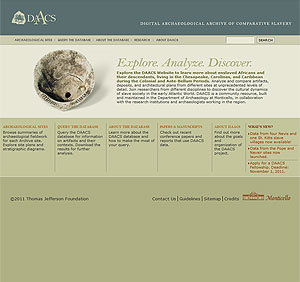Archaeology on Mulberry Row—A Little History: Part 3
In the third and final posting this series, we’ll briefly consider how the intellectual legacies of the New Archaeology affect current archaeological practice and our approach to the reanalysis of Pi-Sunyer (part 1) and Kelso’s (part 2) finds on Mulberry Row.
Today, 30 years after Kelso’s work began on Mulberry Row, archaeologists are still struggling to work out the implications of the New Archaeology and its ambitious explanatory and scientific goals. Some prehistoric archaeologists and nearly all historical archaeologists have rejected those goals in favor of an approach that is more humanistic and interpretive, in which archaeological statements about the past are evaluated largely in terms of their contemporary emotional and political importance. The result, post-processual archaeology, is an archaeological manifestation of postmodernism.
Others have refused to give up on New Archaeology’s scientific goals, while recognizing the movement’s naiveté about how science actually works and its myopia over the critical role played by causal models in scientific inference. They are working to develop the missing theoretical tools by drawing on recent intersecting advances in evolutionary approaches to anthropology, economics, and ecology. On the empirical side, they are simultaneously exploring the potentials of new digital database technologies to organize and question archaeological data and of modern statistical methods to reveal unsuspected patterns in them. Much of our current archaeological work at Monticello is inspired by this approach.
A key component of that work is the Mulberry Row Reassessment, which aims to use a rigorous set of classification and measurement protocols, developed by the DAACS (Digital Archaeological Archives of Comparative Slavery) project based here at Monticello, to digitize field records, maps, and artifact data from Pi-Sunyer’s and Kelso’s excavations. We are making the results available to scholars and the public via the DAACS website (http://www.daacs.org). This decade-long project, funded by the Mellon Foundation, The National Endowment of the Humanities, and the late Robert H. Smith, will be complete this year. But digitization is just the beginning. The ongoing analysis of the results is yielding new insights into radical changes in the lifeways of the enslaved laborers and their families who lived on Mulberry Row and of Jefferson and his family members. We will be reporting some of those results in future blog posts. The fact that new discoveries await us in the boxes of field records and artifacts left behind by our predecessors is powerful testimony to the care they devoted to their excavations and to the potential of new approaches and methods.
Fraser D. Neiman
Director of Archaeology
To learn more...
Matthew Johnson’s Archaeological Theory: An Introduction, Second Edition (2010) is a valuable introduction to the origins and diversity of theoretical perspectives in contemporary archaeology, although it is written from a decidedly post-processual perspective. For a recent review of evolutionary approaches in archaeology, see Stephen Shennan’s “Evolution in Archaeology”, Annual Review of Anthropology Vol. 37: 75-91 (2008). Martin Carver’s Archaeological Investigation (2009) offers an up-to-date and provocative introduction to archaeological field techniques.


